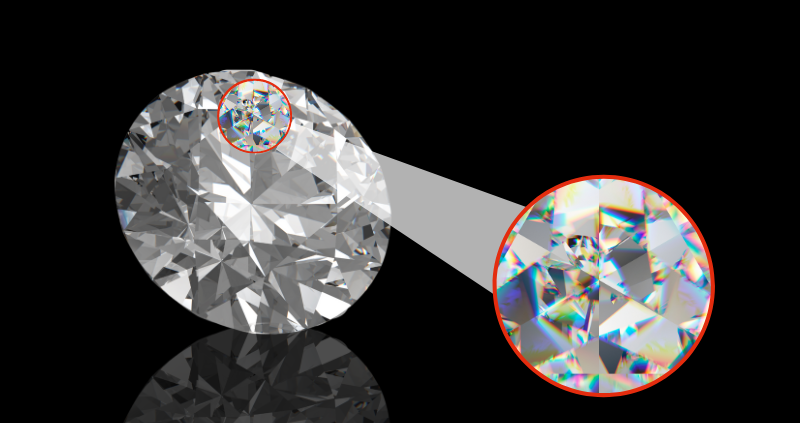Diamond Inclusions: Types, Origin, and Historical Significance
Diamonds are renowned for their clarity and sparkle, but did you know that most diamonds contain flaws called “inclusions”?

Diamond inclusions are internal imperfections can come in various forms, from tiny crystal specks to dark, feather-like lines. Despite their reputation for being blemishes, diamond inclusions actually play a crucial role in determining a diamond's authenticity and value.
Throughout history, diamond inclusions have also been prized for their ability to provide clues about the geologic history of the earth. Let's take a closer look at the fascinating world of diamond inclusions, their types, origins and historical significance.
Origins of Diamond Inclusions
Diamond inclusions give each diamond its unique character and story. The formation of a diamond is a complex process that involves high-pressure conditions and extreme temperatures deep within the Earth's mantle. As a result, the formation stage can also result in the creation of inclusions. External factors such as pressure changes, temperature fluctuations, and reaction with other minerals during the diamond's journey to the surface can also significantly affect the type and number of inclusions.
In some cases, inclusions can become dislodged or rearranged during the polishing process. By examining the nature and location of inclusions, gemologists can determine a diamond's age and origin, as well as identify treatments that may have been applied to improve a diamond's appearance. While advancements in technology have improved our ability to identify and interpret inclusions, the beauty of diamond inclusions lies in their imperfection and natural character. Some may even argue that inclusions add charm and personality to a diamond.
Types of Diamond Inclusions
When you examine a diamond under a microscope, it’s easy to spot inclusions, which are essentially impurities and irregularities within the diamond’s crystal structure.
- Crystals are among the most common inclusions. These are large, three-dimensional formations and can often be seen with the naked eye.
- Pinpoints are small white dot-like inclusions that appear in clusters.
- Clouds are translucent or opaque formations that resemble a cloudy sky.
- Feathers are another category of inclusions, which can be a bit tricky. These are essentially cracks within the diamond, which can resemble feathers when viewed closely.
- There are needles, thin, elongated inclusions that resemble minuscule rods.
It’s important to note that not all inclusions are created equal. While some may seem commonplace, the type, size, and location of an inclusion can significantly impact the quality and value of a diamond. So, the next time you’re marveling at a diamond’s beauty, take a closer look at its inclusions - they’re part of what makes each diamond unique!
Famous Diamonds with Inclusions
Some of the most famous diamonds in history contain these impurities, such as the Dresden Green Diamond, Strawn-Wagner Diamond, and Golden Jubilee Diamond. The Dresden Green Diamond has a unique green colour and contains numerous inclusions, while the Strawn-Wagner Diamond is known for its distinctive colour and the Golden Jubilee Diamond has both internal and external blemishes. These inclusions give these diamonds a unique character and history, making them even more fascinating to behold.
In conclusion, diamond inclusions provide valuable insights into the formation, age, and origin of diamonds. They come in different types, each with its own characteristics and origins. Despite their small size, diamond inclusions have played a significant role in history, from being regarded as flaws and defects to being highly prized for their rarity and beauty. With the advancement of technology, the identification and interpretation of diamond inclusions have become more precise and sophisticated. Understanding diamond inclusions adds to the fascination and appreciation of diamonds, making them even more remarkable and captivating.

